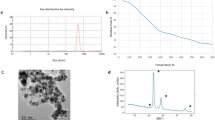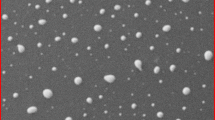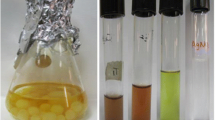Abstract
Iron exopolysaccharide nanoparticles were biogenerated during ferric citrate fermentation by Klebsiella oxytoca DSM 29614. Before investigating their effects on Tuber borchii (“bianchetto” truffle) mycelium growth and morphology, they were tested on human K562 cell line and Lentinula edodes pure culture and shown to be non-toxic. Using these nanoparticles as iron supplement, the truffles showed extremely efficient iron uptake of over 300 times that of a commercial product. This avoided morphological changes in T. borchii due to lack of iron during growth and, with optimum nanoparticle dosage, increased growth without cell wall disruption or alteration of protoplasmatic hyphal content, the nuclei, mitochondria, and rough endoplasmic reticula being preserved. No significant modifications in gene expression were observed. These advantages derive from the completely different mechanism of iron delivery to mycelia compared to commercial iron supplements. The present data, in fact, show the nanoparticles attached to the cell wall, then penetrating it non-destructively without damage to cell membrane, mitochondria, chromatin, or ribosome. Low dosage significantly improved mycelium growth, without affecting hyphal morphology. Increases in hyphal diameter and septal distance indicated a healthier state of the mycelia compared to those grown in the absence of iron or with a commercial iron supplement. These positive effects were confirmed by measuring fungal biomass as mycelium dry weight, total protein, and ergosterol content. This “green” method for biogenerating iron exopolysaccharide nanoparticles offers many advantages, including significant economic savings, without toxic effects on the ectomycorrhizal fungus, opening the possibility of using them as iron supplements in truffle plantations.





Similar content being viewed by others
Explore related subjects
Discover the latest articles and news from researchers in related subjects, suggested using machine learning.References
Abbaspour N, Hurrell R, Kelishadi R (2014) Review on iron and its importance for human health. J Res Med Sci. 19(2):164–174
Amicucci A, Zambonelli A, Iotti M, Polidori E, Menotta M, Saltarelli R, Potenza L, Stocchi V (2010) Morphological and molecular modifications induced by different carbohydrate sources in Tuber borchii. J Mol Microbiol Biotechnol 18(2):120–128. https://doi.org/10.1159/000297915
Arcon I, Piccolo O, Paganelli S, Baldi F (2012) XAS analysis of a nanostructured iron polysaccharide produced anaerobically by a strain of Klebsiella oxytoca. Biometals 25(5):875–881. https://doi.org/10.1007/s10534-012-9554-6
Baldi F, Minacci A, Pepi M, Scozzafava A (2001) Gel sequestration of heavy metals by Klebsiella oxytoca isolated from iron mat. FEMS Microbiol Ecol 36(2–3):169–174. https://doi.org/10.1111/j.1574-6941.2001.tb00837.x
Baldi F, Marchetto D, Battistel D, Daniele S, Faleri C, De Castro C, Lanzetta R (2009) Iron binding characterization of a capsular polysaccharide produced by Klebsiella oxytoca isolated from mine acid drainage. J Appl Microbiol 107(4):1241–1250. https://doi.org/10.1111/j.1365-2672.2009.04302.x
Baldi F, Marchetto D, Zanchettin D, Sartorato E, Paganelli S, Piccolo O (2010) A bio-generated Fe(III)-binding exopolysaccharide used as new catalyst for phenol hydroxylation. Green Chem 12(8):1405–1409. https://doi.org/10.1039/C004967K
Barbieri E, Gioacchini AM, Zambonelli A, Bertini L, Stocchi V (2005) Determination of microbial volatile organic compounds from Staphylococcus pasteuri against Tuber borchii using solid-phase microextraction and gas chromatography/ion trap mass spectrometry. Rapid Commun Mass Spectrom 19(22):3175–3418. https://doi.org/10.1002/rcm.2209
Berndt C, Lillig CH, Holmgren A (2008) Thioredoxins and glutaredoxins as facilitators of protein folding. BBA–Mol Cell Res 1783(4):641–650. https://doi.org/10.1016/j.bbamcr.2008.02.003
Bradford MM (1976) A rapid and sensitive method for the quantitation of microgram quantities of protein utilizing the principle of protein-dye binding. Anal Biochem 72(1-2):248–254. https://doi.org/10.1016/0003-2697(76)90527-3
Burattini S, Battistelli M, Codenotti S, Falcieri E, Fanzani A, Salucci S (2016) Melatonin action in tumor skeletal muscle cells: an ultrastructural study. Acta Histochem 118(3):278–285. https://doi.org/10.1016/j.acthis.2016.02.004
Ceccaroli P, Saltarelli R, Cesari P, Zambonelli A, Stocchi V (2001) Effects of different carboyhydrate sources on the growth of Tuber borchii Vittad. mycelium strains in pure culture. Mol Cell Biochem 218(1–2):65–70. https://doi.org/10.1023/A:1007265423786
Coe EM, Bowen LH, Speer JA, Wang Z, Sayers DE, Bereman RD (1995) The recharacterization of a polysaccharide iron complex (Niferex). J Inorg Biochem 58(4):269–278. https://doi.org/10.1016/0162-0134(94)00060-N
Deponte M (2013) Glutathione catalysis and the reaction mechanisms of glutathione-dependent enzymes. BBA-Gen Subj 1830(5):3217–3266. https://doi.org/10.1016/j.bbagen.2012.09.018
Dhingra S, Cramer RA (2017) Regulation of sterol biosynthesis in the human fungal pathogen Aspergillus fumigatus: opportunities for therapeutic development. Front Microbiol 8:92. https://doi.org/10.3389/fmicb.2017.00092
Dykman LA, Shchyogolev SY (2017) Interactions of plants with noble metal nanoparticles (review). Sel'Skokhozyaistvennaya Biologiya 52(1):13–24. https://doi.org/10.15389/agrobiology.2017.1.13eng
Eskandari H, (2011) Intercropping of wheat (Triticum aestivum) and bean (Vicia faba): Effects of complementarity and competition of intercrop components in resource consumption on dry matter production and weed growth. Afr J Biotechnol 10(77):17755-17762. https://doi.org/10.5897/AJB11.2250
Galluzzi L, Chiarantini L, Pantucci E, Curci R, Merikhi J, Hummel H, Bachmann PK, Manuali E, Pezzotti G, Magi M (2012) Development of a multilevel approach for the evaluation of nanomaterials toxicity. Nanomedicine 7(3):393–409. https://doi.org/10.2217/nnm.11.106
Guerinot ML, Yi Y (1994) Iron: nutritious, noxious, and not readily available. Plant Physiol 104(3):815–820. https://doi.org/10.1104/pp.104.3.815
Haas H, Eisendle M, Turgeon BG (2008) Siderophores in fungal physiology and virulence. Annu Rev Phytopathol 46(1):149–187. https://doi.org/10.1146/annurev.phyto.45.062806.094338
Hall IR, Wang Y, Amicucci A (2003) Cultivation of edible ectomycorrhizal mushrooms. Trends Biotechnol 21(10):433–438. https://doi.org/10.1016/S0167-7799(03)00204-X
Hall IR, Brown GT, Zambonelli A (2007) Taming the truffle. The history, lore, and science of the ultimate mushroom. Timber Press, Portland
Hall IR, Fitzpatrick N, Miros P, Zambonelli A (2017) Counter-season cultivation of truffles in the southern hemisphere: an update. Ital J Mycol 46:21–36. https://doi.org/10.6092/issn.2531-7342/6794
Hatvani N, Mécs I (2003) Effects of certain heavy metals on the growth, dye decolorization, and enzyme activity of Lentinula edodes. Ecotox Environ Safe 55(2):199–203. https://doi.org/10.1016/S0147-6513(02)00133-1
Högberg MN (2006) Discrepancies between ergosterol and the phospholipid fatty acid 18:2ω6,9 as biomarkers for fungi in boreal forest soils. Soil Biol Biochem 38(12):3431–3435. https://doi.org/10.1016/j.soilbio.2006.06.002
Hu J, Guo H, Li J, Gan Q, Wang Y, Xing B (2017) Comparative impacts of iron oxide nanoparticles and ferric ions on the growth of Citrus maxima. Environ Pollut 221:199–208. https://doi.org/10.1016/j.envpol.2016.11.064
Iotti M, Amicucci A, Stocchi V, Zambonelli A (2002) Morphological and molecular characterisation of mycelia of some Tuber species in pure culture. New Phytol 155(3):499–505. https://doi.org/10.1046/j.1469-8137.2002.00486.x
Iotti M, Piattoni F, Zambonelli A (2012) Techniques for host plant inoculation with truffles and other edible ectomycorrhizal mushrooms. In: Zambonelli A, Bonito GM (eds) Edible ectomycorrhizal mushrooms, Current knowledge and future prospects. Soil Biol. 34:145–161. Springer-Verlag, Berlin Heidelberg, Germany. https://doi.org/10.1007/978-3-642-33823-6
Iotti M, Piattoni F, Leonardi P, Hall IR, Zambonelli A (2016) First evidence for truffle production from plants inoculated with mycelial pure cultures. Mycorrhiza 26(7):793–798. https://doi.org/10.1007/s00572-016-0703-6
Jurado J, Prieto-Álamo MJ, Madrid-Rísquez J, Pueyo C (2003) Absolute gene expression patterns of thioredoxin and glutaredoxin redox systems in mouse. J Biol Chem 278(46):45546–45554. https://doi.org/10.1074/jbc.M307866200
Kanmani P, Lim ST (2013) Synthesis and characterization of pullulan-mediated silver nanoparticles and its antimicrobial activities. Carbohydr Polym 97(2):421–428. https://doi.org/10.1016/j.carbpol.2013.04.048
Karliński L, Rudawska M, Kieliszewska-Rokicka B, Leski T (2010) Relationship between genotype and soil environment during colonization of poplar roots by mycorrhizal and endophytic fungi. Mycorrhiza 20(5):315–324. https://doi.org/10.1007/s00572-009-0284-8
Kosman DJ (2003) Molecular mechanisms of iron uptake in fungi. Mol Microbiol 47(5):1185–1197. https://doi.org/10.1046/j.1365-2958.2003.03368.x
Leonardi P, Iotti M, Zeppa S, Donati S, Lancellotti E, Amicucci A, Zambonelli A (2017) Morphological and functional changes in mycelium and mycorrhizas of Tuber borchii due to heat stress. Fungal Ecol 29:20–30. https://doi.org/10.1016/j.funeco.2017.05.003
Leone S, De Castro C, Parrilli M, Baldi F, Lanzetta R (2007) Structure of the iron binding polysaccharide produced anaerobically by the gram-negative bacterium Klebsiella oxytoca BAS-10. Eur J Org Chem 2007(31):5183–5189. https://doi.org/10.1002/ejoc.200700302
Lolkema JS, Enequist H, Van Der Rest ME (1994) Transport of catalyzed by the sodium-dependent citrate carrier of Klebsiella pneumoniae is obligatory coupled to the transport of two sodium ions. Eur J Biochem 220(2):469–475. https://doi.org/10.1111/j.1432-1033.1994.tb18645.x
Mamoun M, Olivier JM (1993) Effect of iron amendment on the development of the ectomycorrhizal fungus Tuber melanosporum and the rhizoplane bacteria. Eur J Soil Biol 29(2):83–90
Mandal D, Bolander ME, Mukhopadhyay D, Sarkar G, Mukherjee P (2006) The use of microorganisms for the formation of metal nanoparticles and their application. Appl Microbiol Biotechnol 69(5):485–492. https://doi.org/10.1007/s00253-005-0179-3
Mannervik B (1987) The enzymes of glutathione metabolism: an overview. Biochem Soc 15(4):717–718. https://doi.org/10.1042/bst0150717
Meister A (1988) Glutathione metabolism and its selective modification. J Biol Chem 263(33):17205–17208
Mengel K, Kirkby EA (2001) Iron. In: Mengel K, Kirkby EA (eds) Principles of plant nutrition, 5th edn. Kluwer Academic Publishers, Boston, pp 553–571. https://doi.org/10.1007/978-94-010-1009-2_13
Menotta M, Amicucci A, Basili G, Rivero F, Polidori E, Sisti D, Stocchi V (2007) Molecular characterisation of the small GTPase CDC42 in the ectomycorrhizal fungus Tuber borchii Vittad. Protoplasma 231(3–4):227–237. https://doi.org/10.1007/s00709-007-0254-y
Menotta M, Amicucci A, Basili G, Polidori E, Stocchi V, Rivero F (2008) Molecular and functional characterization of a rho GDP dissociation inhibitor in the filamentous fungus Tuber borchii. BMC Microbiol 8(1):57. https://doi.org/10.1186/1471-2180-8-57
Miller JK, Badawy HT, Clemons C, Kreider KL, Wilber P, Milsted A, Young G (2012) Development of the Pseudomonas aeruginosa mushroom morphology and cavity formation by iron-starvation: a mathematical modeling study. J Theor Biol 308:68–78. https://doi.org/10.1016/j.jtbi.2012.05.029
Molina R (1979) Ectomycorrhizal inoculation of containerized Douglas-fir and lodgepole pine seedlings with six isolates of Pisolithus tinctorius. For Sci 25:585–590
Montenegro L, Trapani A, Fini P, Mandracchia D, Latrofa A, Cioffi N, Chiarantini L, Picceri GG, Brundu S, Puglisi G (2014) Chitosan nanoparticles for topical co-administration of the antioxidants glutathione and idebenone: characterization and in vitro release. Brit J Pharm Res 4(20):2387–2406. https://doi.org/10.9734/BJPR/2014/8641
Navarro E, Baun A, Behra R, Hartmann NB, Filser J, Miao AJ, Quigg A, Santschi PH, Sigg L (2008) Environmental behavior and ecotoxicity of engineered nanoparticles to algae, plants, and fungi. Ecotoxicology 17(5):372–386. https://doi.org/10.1007/s10646-008-0214-0
Nel A, Xia T, Mädler L, Li N, Nel A (2006) Toxic potential of materials at the nano level. Science 311(5761):622–627. https://doi.org/10.1126/science.1114397
Nylund JE, Wallander H (1992) Ergosterol analysis as a means of quantifying mycorrhizal biomass. Method Microbiol 24:77–88. https://doi.org/10.1016/S0580-9517(08)70088-6
Ogidi OC, Nunes MD, Oyetayo VO, Akinyele BJ, Megumi Kasuya MC (2016) Mycelial growth, biomass production and iron uptake by mushrooms of Pleurotus species cultivated on Urochloa decumbens (Stapf) R. D. Webster. J Food Res 5(3):13–19. https://doi.org/10.5539/jfr.v5n3p13
Panacek A, Kvítek L, Prucek R, Kolar M, Vecerova R, Pizúrova N, Sharma VK, Nevecna T, Zboril R (2006) Silver colloid nanoparticles: synthesis, characterization, and their antibacterial activity. J Phys Chem B 110(33):16248–16253. https://doi.org/10.1021/jp063826h
Pfaffl MW (2001) A new mathematical model for relative quantification in real-time RT–PCR. Nucleic Acids Res 29(9):2002–2007. https://doi.org/10.1093/nar/29.9.e45
Philpott CC (2006) Iron uptake in fungi: a system for every source. Biochim Biophys Acta 1763(7):636–645. https://doi.org/10.1016/j.bbamcr.2006.05.008
Potenza L, Saltarelli R, Polidori E, Ceccaroli P, Amicucci A, Zeppa S, Zambonelli A, Stocchi V (2012) Effect of 300 mT static and 50 Hz 0.1 mT extremely low frequency magnetic fields on Tuber borchii mycelium. Can J Microbiol 58(10):1174–1182. https://doi.org/10.1139/w2012-093
Raja S, Mallesha BC, Gowda PA (2013) Effect of micronutrients on growth and yield of mushrooms. Mysore J Agric Sci 47(1):66–69
Rui M, Ma C, Hao Y, Guo J, Rui Y, Tang X, Zhao Q, Fan X, Zhang Z, Hou T, Zhu S (2016) Iron oxide nanoparticles as a potential iron fertilizer for peanut (Arachis hypogaea). Front Plant Sci 7:815. https://doi.org/10.3389/fpls.2016.00815
Salamanna F, Frizziero A, Pagani S, Giavaresi G, Curzi D, Falcieri E, Marini M, Abruzzo PM, Martini L, Fini M (2015) Metabolic and cytoprotective effects of in vivo peri-patellar hyaluronic acid injections in cultured tenocytes. Connect Tissue Res 56(1):35–43. https://doi.org/10.3109/03008207.2014.979166
Saltarelli R, Ceccaroli P, Vallorani L, Zambonelli A, Citterio B, Malatesta M, Stocchi V (1988) Biochemical and morphological modifications during the growth of Tuber borchii mycelium. Mycol Res 102(4):403–409. https://doi.org/10.1017/S0953756297004875
Sathiyanarayanan G, Krishnamoorthy D, Yung-Hun Y (2017) Microbial exopolysaccharide-mediated synthesis and stabilization of metal nanoparticles. Crit Rev Microbiol 43(6):731–752. https://doi.org/10.1080/1040841X.2017.1306689
Schulte EE (2004) Soil and applied iron. Understanding plant nutrients A3554 Cooperative Extension Publications. University of Wisconsin, Madison
Schwertmann U (1991) Solubility and dissolution of iron oxides. Plant Soil 130(1–2):1–25. https://doi.org/10.1007/BF00011851
Sies H (1999) Glutathione and its role in cellular functions. Free Rad Bio Med 27(9–10):916–921. https://doi.org/10.1016/S0891-5849(99)00177-X
Smith SE, Read DJ (2008) Mycorrhizal symbiosis. Academic Press, London
Thakkar KN, Mhatre SS, Parikh RY (2010) Biological synthesis of metallic nanoparticles. Nanomedicine 6(2):257–262. https://doi.org/10.1016/j.nano.2009.07.002
Trinci APJ (1973) The hyphal growth unit of wild type and spreading colonial mutants of Neurospora crassa. Arch Microbiol. 91(2):127–136. https://doi.org/10.1007/BF00424756
Vigneshwaran N, Nachane RP, Balasubramanya RH, Varadarajan PV (2006) A novel one-pot ‘green’ synthesis of stable silver nanoparticles using soluble starch. Carbohydr Res 341(12):2012–2018. https://doi.org/10.1016/j.carres.2006.04.042
Wallander H, Ekblad A, Godbold DL, Johnson D, Bahr A, Baldrian P, Björk RG, Kieliszewska-Rokicka B, Kjøller R, Kraigher H, Plassard C, Rudawska M (2013) Evaluation of methods to estimate production, biomass and turnover of ectomycorrhizal mycelium in forests soils—a review. Soil Biol Biochem 57:1034–1047. https://doi.org/10.1016/j.soilbio.2012.08.027
Wang YQ, Hu J, Dai ZY, Li JL, Huang J (2016) In vitro assessment of physiological changes of watermelon (Citrullus lanatus) upon iron oxide nanoparticles exposure. Plant Physiol Biochem 108:353–360. https://doi.org/10.1016/j.plaphy.2016.08.003
Wei D, Sun W, Qian W, Ye Y, Ma X (2009) The synthesis of chitosan-based silver nanoparticles and their antibacterial activity. Carbohydr Res 344(17):2375–2382. https://doi.org/10.1016/j.carres.2009.09.001
Xia ZK, Ma QH, Li SY, Zhang DQ, Cong L, Tian YL, Yang RY (2016) The antifungal effect of silver nanoparticles on Trichosporon asahii. J Microbiol Immunol Infect 49(2):182–188. https://doi.org/10.1016/j.jmii.2014.04.013
Zambonelli A, Hall I, Fitzpatrick N (2010) Lecture de l'approche de la trufficulture dans l'hémisphère austral à la lumière de l'expèrience italienne. In: Savignac JC (ed) Actes du colloque, Les nouvelles techniques de culture de la truffe. M.G.D, Sarlat, pp 68–77
Zambonelli A, Iotti M, Hall IR (2015) Current status of truffle cultivation: recent results and future perspectives. Ital J Mycol 44:31–40. https://doi.org/10.6092/issn.2465-311X/5593
Zambonelli A, Iotti M, Murat C (eds) (2016) True truffles (Tuber spp.) in the world. Soil Biology series, vol 47. Springer International Publishing AG, Cham. https://doi.org/10.1007/978-3-319-31436-5
Zeppa S, Vallorani L, Potenza L, Bernardini F, Pieretti B, Guescini M, Giomaro G, Stocchi V (2000) Estimation of fungal biomass and transcript levels in Tilia platyphyllos-Tuber borchii ectomycorrhizae. FEMS Microbiol Lett 188(2):119–124. https://doi.org/10.1111/j.1574-6968.2000.tb09181.x
Author information
Authors and Affiliations
Corresponding author
Ethics declarations
Conflict of interest
The authors declare that they have no conflict of interest.
Ethical approval
This article does not contain any studies with human participants or animals performed by any of the authors.
Electronic supplementary material
ESM 1
(PDF 272 kb)
Rights and permissions
About this article
Cite this article
Picceri, G.G., Leonardi, P., Iotti, M. et al. Bacteria-produced ferric exopolysaccharide nanoparticles as iron delivery system for truffles (Tuber borchii). Appl Microbiol Biotechnol 102, 1429–1441 (2018). https://doi.org/10.1007/s00253-017-8615-8
Received:
Revised:
Accepted:
Published:
Issue Date:
DOI: https://doi.org/10.1007/s00253-017-8615-8




